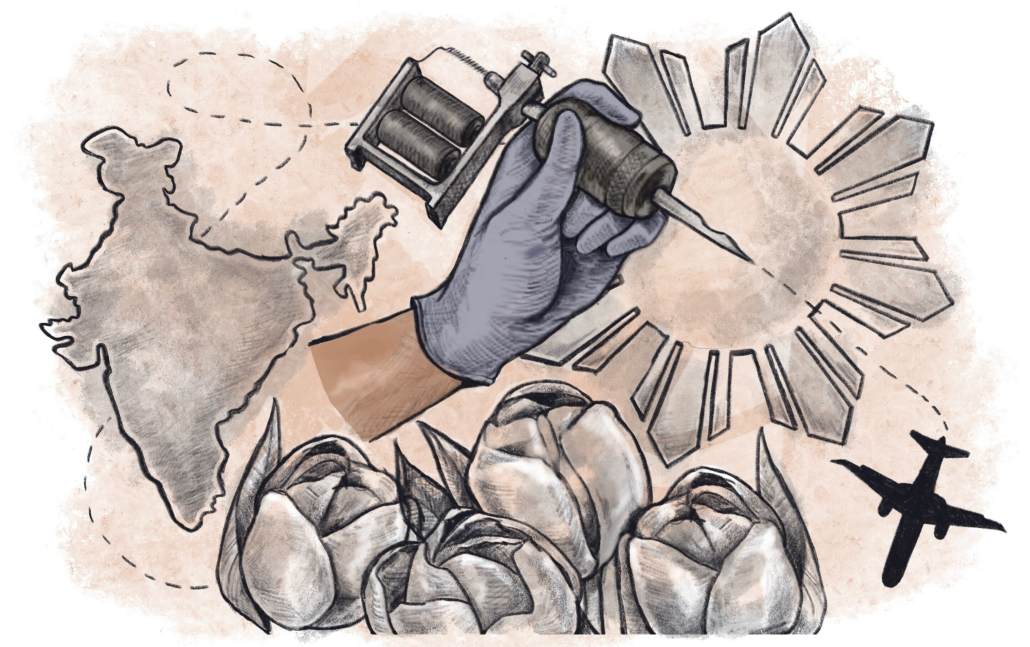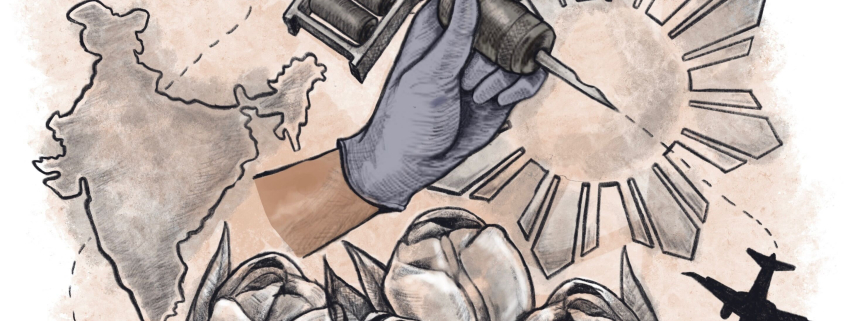First-generation students embrace cultural body art

Michael Cava grew up sleeping under the Philippines’ flag. His parents, immigrants from the Philippines, took him to visit the country when he was eight years old. Cava did not feel like he fit in.
“I felt like an outsider,” Cava said. Everyone can tell you’re an American from a mile away.”
Growing up, Cava had to learn how to accept his cultural heritage. For him, that meant getting a tattoo that would represent his roots. Many first-generation Americans struggle to fit in, according to The Saint Barnabas Health System in the Bronx. The Health System says that first-generation American teenagers often face issues such as culture clash and language barriers.
To deal with these stresses and feel more connected to their cultures, some first-generation students have turned to using body art to express their cultural heritage.
Agnes Kovesdy, a sophomore majoring in physics and computer science, knew she wanted a tattoo, and drew inspiration from her parents’ culture. Kovesdy, whose family is Hungarian, has a tattoo of a tulip on the side of her ribs. She said the beautiful natural landscapes of Hungary inspired her.
“The tulip is the national flower of Hungary, we have a lot of tulip fields and they’re very colorful,” Kovesdy said. “If you drive past you see a lot of them, it’s a very distinctive image to Hungary.”
Kovesdy, whose parents immigrated to the U.S. from Hungary before she was born, grew up moving around Virginia and Tennessee, before ending up in Memphis. Regardless of her location, Kovesdy always kept in touch with her culture. Her first language was Hungarian, and summers in Hungary with her family left her with a sense of belonging in her parents’ home country.
“When I’m visiting my family, there’s very much a feeling of ‘this is my culture, this is my heritage, my family is here,’” Kovesdy said.
When Kovesdy first came up with the idea for her tattoo, she fell in love with it.
“I took a pen and drew a rough design where I wanted to have it. I looked at my pen version in the mirror and I was like ‘I love this. I love this,” Kovesdy said. I had the same moment when I got the actual tattoo. I looked in the mirror and I thought ‘it’s perfect.’”
Kovesdy’s tattoo, which is usually hidden underneath her clothing, means a lot to her.
“I don’t mind if people don’t see it. Me getting a tattoo was something that I wanted on my own body and I didn’t really care if people saw it or not,“ Kovesdy said. “It was something that I wanted them to know I have.”
For Cava, a sophomore majoring in international relations, the path to accepting his culture was not so easy. Cava, who wants to get a tattoo of the Pilipinx tribal sun on his shoulder, didn’t like to talk about his Pilipinx heritage growing up.
“I went to middle school in North Carolina deep in the South and we were the only Asian family there, so growing up there, and other places where there was no minority representation,” Cava said. “I just identified as Asian, I didn’t really talk about it, cause it was all just a segue to fights or getting bullied.”
Growing up, Cava’s family moved around a lot, from San Diego to North Carolina to Chicago to Japan, because of his father who was in the Marines for 22 years. As a result, his family became very tight-knit. When he moved to California before his freshman year of high school, Cava became more in touch with his culture. He grew closer to his extended family, most of whom live in California.
“We’ll have family parties where there’s probably 50 of us, and we’ll just talk, we hang out, we get boba, we make Pilipino food,” Cava said.
After having spent much of his younger years hiding his culture, Cava has matured into accepting his heritage as a part of his identity.
“Now that I’m in California, and I’m older and more mature, I definitely identify as Pilipino,” Cava said. I’m proud to say it, and it’s a big part of who I am.”
Cava’s tattoo will definitely reflect his Pilipino pride. He wants the tattoo to be done by his uncle, a Pilipino tattoo artist, who Cava feels will best carry out his vision. Unlike Kovesdy, Cava wants his tattoo to be visible.
“Being able to finally accept [my heritage] and be proud of it is definitely a coming-of-age moment,” Cava said.
Reshma Ramesh, a sophomore majoring in health and human sciences, had a similar struggle accepting her culture.
“When you’re ashamed of your culture [growing up], you’re forced to go one of two ways,” Ramesh said. You either learn to love your culture, or you learn to hide it. And I’ve learned to love mine.”
Growing up in Bangalore, India, Ramesh always felt connected to her culture. As a homage to her Indian upbringing, Ramesh wants a tattoo of the silhouette of India on the nape of her neck. She thinks with this tattoo, she gets the best of both worlds.
“I feel like, at the nape of the neck, I can hide it if I want to with my hair down, but if I put it up, I know it’s there and I’m not afraid of showing it,” Ramesh said.
Ramesh, Cava, and Kovesdy’s experiences all signify the difficulties many face when trying to hold on mother culture as a first-generation American can be tough. The struggle between assimilation into American culture and preservation of heritage is often compounded by bullying or feeling isolated within their heritage. But as Cava shared, many first-generation Americans learn to love their culture and be proud of it as they grow older, oftentimes celebrating it with tattoos. And when deciding what to put on your body forever, isn’t your heritage a pretty good start?

